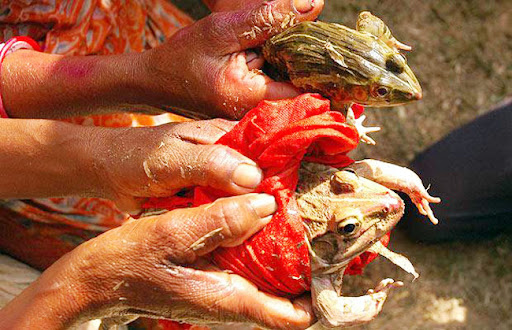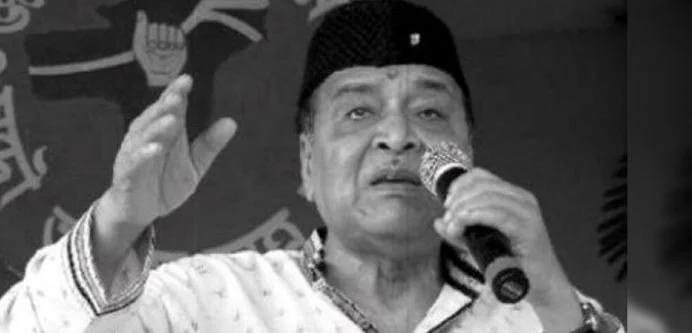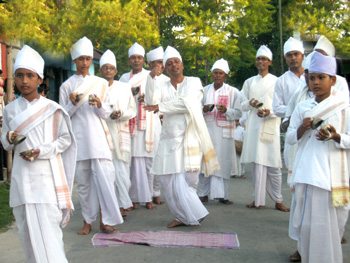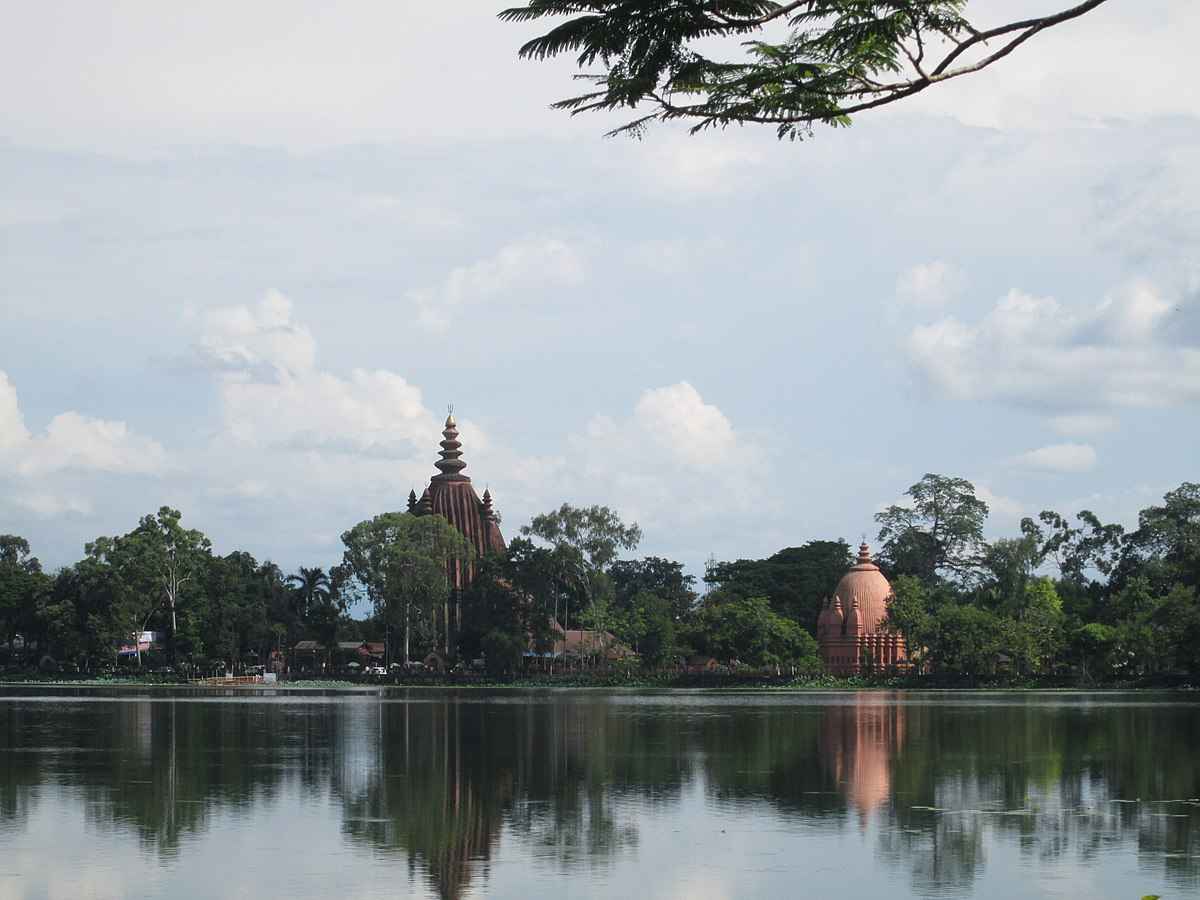In the heart of Assamese culture lies a tradition that defies convention: Bhekuli Biya, or frog weddings. These unique ceremonies take place during scorching summer months, when farmers yearn for the rain to bless their parched fields. Here’s a glimpse into this enchanting custom:
- Origins and Beliefs:
- Bhekuli Biya traces its roots to ancient times. Legend has it that farmers, desperate for rain, questioned the clouds. The frogs, with their croaking, became the messengers between humans and Varun Devta, the rain god.
- The term “Bhekuli Biya” itself reflects the poetic fusion of nature and tradition.
- The Ceremony:
- A priest or village elder officiates the ceremony. Two frogs are caught, cleaned, and adorned in miniature Assamese wedding attire.
- The frogs sit on a platform, tied together with a red thread. The female frog receives vermilion on her forehead, symbolizing her union with the male frog.
- Melodic prayers fill the air, invoking Varun Devta’s blessings.
- Release and Honeymoon:
- After the ritual, the frogs are released into a nearby pond or stream. The belief? If they stay together, rain will follow.
- It’s their honeymoon—a union meant to appease the rain god and bring prosperity to the land.
- Cultural Significance:
- Bhekuli Biya reflects Assamese folk culture, blending tradition, belief, and ecological awareness.
- The frogs’ croaking is intricately tied to monsoon rains, making them the harbingers of life-giving water.
- Modern Context:
- Even today, Bhekuli Biya ceremonies occur during heatwaves or floods, a testament to their enduring relevance.
- In 2019, Bhopal witnessed a symbolic “frog divorce” ceremony during the Indian floods.
Origins and Beliefs
Ancient Roots:
- Bhekuli Biya has its origins in the heart of Assam, India. It is a tradition that dates back centuries.
- According to folklore, desperate farmers sought a way to communicate with the rain gods during droughts. They turned to frogs—the amphibious messengers between earth and sky.
The Frog’s Role:
- Frogs, with their incessant croaking, became the intermediaries. Their calls were believed to reach Varun Devta, the rain god.
- The frogs symbolized hope, bridging the gap between human longing and divine intervention.
Etymology:
- The term “Bhekuli Biya” itself carries poetic weight. “Bhekuli” refers to frogs, and “Biya” means marriage.
- Thus, frog weddings—Bhekuli Biya—became a unique way to invoke rain and ensure bountiful harvests.
The Ceremony
- Preparation:
- Role of the Priest or Village Elder:
- A priest or an esteemed village elder officiates the Bhekuli Biya ceremony.
- They play a crucial role in ensuring the ritual’s sanctity and adherence to tradition.
- Frog Selection and Attire:
- Two frogs are carefully chosen for the union.
- They are caught from nearby ponds or wetlands.
- The frogs undergo a gentle cleaning process.
- Dressed in miniature Assamese wedding attire, they become the tiny bride and groom.
- Symbolism of Frog Attire:
- Dressing up the frogs symbolizes their transformation into sacred beings.
- The attire mirrors traditional human wedding garments, emphasizing the solemnity of the occasion.
- Role of the Priest or Village Elder:
- The Ritual:
- Wedding Proceedings:
- The frogs sit on a decorated platform, much like a mandap (wedding canopy).
- They are tied together with a delicate red thread, signifying their union.
- The male frog, adorned with a tiny topor (Assamese groom’s headgear), awaits his bride.
- Melodic Prayers:
- The priest chants prayers, invoking blessings from Varun Devta, the rain god.
- Melodies fill the air, creating an ethereal atmosphere.
- Vermilion Application:
- The female frog receives a vermilion mark on her forehead.
- This act signifies her commitment as the male frog’s life partner.
- The vermilion represents the sacred bond they share.
- Wedding Proceedings:
- The Blessings:
- Puja (Prayer) for Rain:
- The priest performs a puja, seeking Varun Devta’s favor.
- The frogs’ union becomes a plea for timely rains and abundant crops.
- Hope and Belief:
- The villagers watch with anticipation, hoping that the frogs’ marriage will appease the rain god.
- Their union symbolizes harmony between nature and humanity.
- Puja (Prayer) for Rain:
- Release and Honeymoon:
- After the Ceremony:
- Once the rituals are complete, the frogs are released into a nearby pond or stream.
- It’s their honeymoon—a journey into the water, where they become part of the ecosystem.
- Belief in Rain Follows Unity:
- The villagers believe that if the frogs stay together, rain will soon grace their land.
- Successful Bhekuli Biya ceremonies are celebrated as auspicious signs.
- After the Ceremony:
In this whimsical tradition, frogs become more than amphibians; they become emissaries of hope, bridging the gap between earth and sky.
Cultural Significance
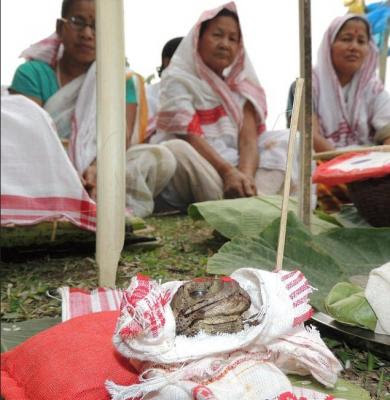
- Folk Tradition:
- Bhekuli Biya is deeply rooted in Assam’s rural traditions.
- Organizing frog weddings is more than a ritual; it’s a celebration of nature’s cycles and the symbiotic relationship between humans and their environment.
- Frog Croaking and Rain:
- The connection between frog croaking and monsoon rains is central to Bhekuli Biya.
- Assamese folklore believes that frogs’ calls are a plea to Varun Devta, the rain god.
- When frogs croak, it signifies their anticipation of rain, echoing the villagers’ hopes for a bountiful harvest.
Modern Context
- The Ceremony:
- A priest or village elder conducts the ritual.
- Two frogs are caught, cleaned, and dressed in traditional Assamese wedding attire.
- They sit on a platform, tied together with a red thread.
- The priest performs a puja (prayer) to seek the rain god’s blessings.
- Vermilion is applied to the female frog’s forehead, signifying her as the male frog’s life partner.
- After the puja, the frogs are released into a nearby pond or stream.
- If the frogs stay together, it’s believed that the rain god has been appeased, and rain will follow.
- 2019 Indian Floods and the Symbolic “Frog Divorce”:
- Amid the devastating 2019 Indian floods, a unique event occurred in Bhopal. The local group “Om Shiva Sewa Shakti Mandal” performed a “frog divorce.”
- Two clay frogs were symbolically separated, expressing hope that the region would find relief from the destruction caused by heavy rain.
- This symbolic act aimed to appease Varun Devta, the rain god from Hindu mythology, and bring much-needed rain.
Conclusion
In conclusion, the Frog Wedding serves as a powerful example of the rich cultural heritage and spiritual beliefs rooted in ancient traditions. While some might view it as merely a superstitious ritual, for many, it represents hope, faith, and the harmonious coexistence of humans and nature. The continuation of such practices underscores the importance of preserving cultural diversity and understanding the ways in which communities around the world seek to influence and interact with their environment.
FAQ’s
Q. What is Bhekuli Biya?
A: Bhekuli Biya, also known as the Frog Wedding, is a traditional ritual practiced in some parts of India, particularly in Assam, where two frogs are married to appease the rain gods and invoke rainfall during times of drought.
Q. How is the Frog Wedding conducted?
A: The ceremony is conducted with all the rituals of a traditional Hindu wedding. The frogs are dressed up, and mantras are chanted by a priest. The frogs are then “married” in a symbolic ceremony, followed by a feast and other customary celebrations.
Q. Does the Frog Wedding actually bring rain?
A: There is no scientific evidence to support the belief that the Frog Wedding brings rain. However, it is a practice steeped in faith and tradition, and for many, the ceremony is more about hope and community spirit than actual meteorological effects.


